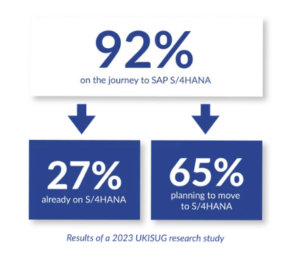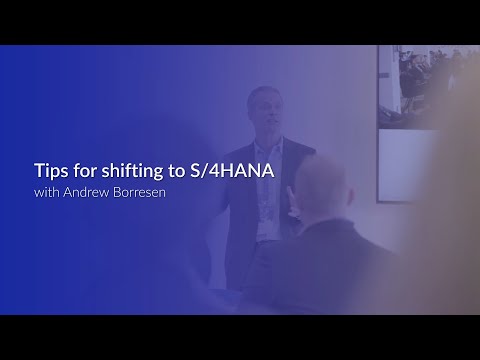A day doesn’t go by where I don’t hear the words ‘S/4HANA journey’.
 It seems many organisations have either moved some parts of their estate to S/4HANA, or are actively analysing their next steps. A research study done at the end of 2023 by the UK and Ireland SAP User Group (UKISUG) showed that 92% of their user sample are either on S/4HANA (27%) or planning to move to S/4HANA (65%). This demonstrates how much of the market is on the journey to adopt SAP S/4HANA.
It seems many organisations have either moved some parts of their estate to S/4HANA, or are actively analysing their next steps. A research study done at the end of 2023 by the UK and Ireland SAP User Group (UKISUG) showed that 92% of their user sample are either on S/4HANA (27%) or planning to move to S/4HANA (65%). This demonstrates how much of the market is on the journey to adopt SAP S/4HANA.
No matter how you are looking at the project, moving to S/4HANA is a huge endeavour – and also the ideal time to rethink how you have implemented SAP, and how to optimise business processes.
At EPI-USE Labs, we have numerous SAP data experts. We sometimes use the term ‘data surgeons’ because of their exceptional ability to slice, move and manage SAP data! Our specialist software called the Data Sync Manager™ (DSM) Suite has been used by thousands of organisations around the world to copy and scramble clients and data objects for testing and training for over 24 years. And we enhanced this software even further to provide support during business projects like Mergers and Acquisitions (M&A), and transformation projects like moving to S/4HANA.
With our PRISM solutions, we move on-premises SAP HCM Payroll to SAP SuccessFactors Employee Central Payroll (ECP). We also use this capability to support any selective data transition when you move to S/4HANA. But that is only a small part of the larger project.
To get deeper insights, I spoke to Andrew Borresen, CTO from our sister company G3G, about his experience around what the critical factors for successful S/4HANA projects are.

Andrew Borresen | SAP Advisory Lead and CTO | G3G
Andrew is a seasoned Technology Executive with 24 years of business and SAP technology transformation leadership across consulting advisory, enterprise, and solution architecture disciplines. He has proven success in architecting solutions to support global business transformation initiatives, with experience in divestiture carve-outs, ERP platform consolidation programs through mergers and acquisitions, greenfield ERP installations and upgrades, and continuous business improvement initiatives.

What are your top tips to clients who are starting with their S/4HANA project?
When we start to engage with clients, the first thing we do is to understand the client’s perspective on project objectives. This discussion helps us work out if there is a possibility to do some business transformation, or just a technical upgrade. And walking through this in some detail and playing it back to our clients helps us to set and manage expectations. We have seen that clients don’t always think about all the possibilities up front. So, talking about the objectives is a key place to start.
Secondly, we encourage clients to choose a proven, comprehensive methodology backed by SAP addressing business value discovery through to Application Lifecycle Management (ALM).
Then, the ace up your sleeve should be looking at accelerators and powerful software you can incorporate before, during and after your project. The EPI-USE Labs’ solutions are a good example of how clients can leverage products to bring immense value to the project. I have been impressed with the return on investment (ROI) clients can get by implementing Data Sync Manager to reduce their non-production footprint, for example.
By leveraging software and accelerators, you lower your risk and can get high predictability while reducing overall project cost and duration, and lowering the barrier of entry to S/4HANA.
Lastly, the success of your S/4HANA project can will depend on setting up some specialist teams. You need people to focus on areas such as advisory, functional, technical, Cloud infrastructure, mobility and testing. With G3G’s assessment, we take a ‘deep dive’ into the different streams needed for the project, and make recommendations across the board. Our experience has shown you need a strong track record across industries and delivery support models (cloud, technical, functional) to make the project a success.
You have touched on experts. What type of skillsets do people require going forward?
It is important that organisations are aware that a lot of the skillsets required are different. So you may have an in-house team today, but a lot of their skills will need to change. So as you consider your project, consider what blend you’re going to use from your in-house team, from consultants, or further upskilling your team in-house.
To mention two examples:
It’s critical to have Fiori expertise on your S/4HANA conversion project as well. With the interface having changed, the skill requirements are different. So your typical ABAP developers are not necessarily going to translate across to Fiori developers.
Secondly, SAP’s Business Technology Platform (BTP) is the cornerstone of SAP’s innovation strategy and supports capability around AI, workflow and external stakeholder access, as well as low code development, analytics and integration. If S/4HANA is the invitation to the party, BTP puts you straight into the VIP section where you can leverage all that SAP has to offer for digitising your business and surpassing your market competitors.
So you need to consider either upskilling your own team, or bringing in the appropriate consultants during your S/4 project, depending on how many innovations you decide to adopt and which new capabilities in BTP to introduce.
As well as expertise, you have also spoken about ‘cloud mindset’. Can you expand on that?
A cloud mindset is crucial for effective change management and project success in the new world. Methodologies have changed. And a lot more of the responsibility for the implementation now falls on the client, what we call client self-enablement. So what that means is that right from the early phases of the project, you’re starting with your change management, you’re getting your users involved in testing the system so they know exactly what they’re going to get when it goes live.
This is also helpful in supporting what are typically shorter project cycles now. We’re not wanting to do monolithic eighteen month to two-year projects anymore. We want to be able to adopt cloud solutions, including S/4HANA Cloud very, very quickly. So this is what’s required for that.
The second part of cloud mindset is also understanding that the way we make changes to the system has changed. In the past, we used to customise our core solution a lot; in the future, we want to rather customise on cloud platforms that run alongside our core solution.
So that when we want to upgrade in the future, it’s very, very easy to do so.
The new way to approach customisations is to adopt a ‘clean core’ by moving your developments and integrations to SAP BTP. What has your experience been with BTP?
The BTP platform is an excellent platform for clients to leverage. From no code/low code capabilities to leveraging the latest AI solutions, it can be a game-changer for our clients. We have recently collaborated with EPI-USE Labs in developing a BTP application for a client to manage their proof of delivery. I get excited about what we can achieve with the BTP technology to enhance the usability and adoption of SAP S/4HANA.
Any last thoughts for people to consider?
Business is always affected. However you approach your S/4HANA project, there will be an impact on the business. So, we see a lot of times we’re dealing with CIOs, and they’re trying to do a technical upgrade behind the scenes so to speak, which is all good and well, but they are mandatory adaptations that need to happen as part of an S/4 upgrade as well.
So, my recommendation is to engage your business as early as possible, even in a process of doing a proof of concept. Once you have an upgraded S/4HANA system from a proof of concept, then use it to start building consensus within your business for the S/4HANA product. Spend time with them showing them new innovations, showing them the system.
Many thanks to Andrew for answering our questions! Get in touch if you need any further info, or book a free S/4HANA Assessment.
This article first appeared on the EPI-USE site: Critical success factors for SAP S/4HANA projects (epiuselabs.com)



